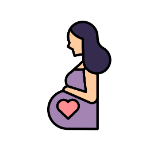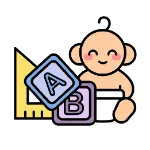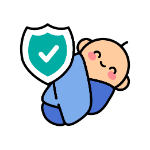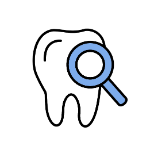
Childcare
Baby Teething Guide: From First Tooth To Beautiful Smile
8 min | Updated on 02-07-2023 by HappyPreggie
(Image credits to Pampers)
It’s a really exciting moment when you see your baby's first little tooth start to come in! But we know, teething can be tough for parents, with sleepless nights, uncertainty, and lots of drool. To help give you peace of mind and make sure your child’s teething experience goes as smoothly as possible, we’ve put together a baby teething guide, just for you. From understanding the baby teeth order to recognizing signs and symptoms, we'll also talk about safe remedies and how to take care of your baby's teeth. By the end of this blog, you will have all the knowledge and support needed to help your baby through this milestone with confidence and care!
What Is Teething and When Does It Start?
Teething is a natural process where your baby’s first set of teeth, also known as primary or baby teeth, start to emerge through the gums.
Every baby is unique, and while they’re all born with 20 teeth in place underneath their gums, the timing of when these teeth break through differs. For most babies, their teeth will begin emerging when they reach 6 to 10 months old, and will be complete when they turn 3. Don’t worry if your 10 month old baby hasn’t started teething yet! Some children begin the process a little later than others, and it’s not usually a cause for concern.
However, if your baby is 18 months old and none of their baby teeth has come in yet, it’s best to visit the dentist so your little one can be evaluated properly for any issues.
Baby Teeth Order
(Image credits to Pampers)
Again, the order can vary from child to child and some of the estimated eruption times overlap. Most commonly, the two bottom front teeth (lower central incisors) are the first to come up and then the upper front teeth come next (upper central incisors). After that, baby teeth tend to show up symmetrically with teeth on both sides of the mouth erupting around the same time (usually the lower teeth before the upper teeth). The last to show up are almost always the second molars. If your child’s baby teeth order doesn’t follow the chart exactly, there’s no need to be alarmed and your paediatric dentist can give you guidance if you feel like something is off.
Recognizing the Signs of Teething
During teething, your baby's gums become sore and tender as the teeth push their way through the gums. This can cause discomfort and irritability, which then leads to changes in eating and sleeping patterns. Other common signs and symptoms of teething include:
- Becoming easily irritated, more cranky and restless than usual.
- Excessive drooling.
- Their gums may appear red, swollen, and may be sensitive to touch.
- Chewing on objects or their own fingers to relieve gum discomfort.
- May temporarily lose their appetite or prefer softer foods.
- The sensation from teething can sometimes be felt in the ears, causing babies to rub or tug at their ears.
Remember, not all babies go through the same teething experience; some may make minimal fuss whole others have more pronounced symptoms. Whichever it is, remember that teething is a normal part of your baby's development and is not considered a serious health issue.
Soothing Strategies for Teething Babies
(Image credits to iStock)
To help soothe a teething baby, there are several strategies you can try:
- Gentle gum massage: Using a clean finger, gently rub the baby's gums to provide relief.
- Cold therapy: Chilled teething rings, pacifiers, or a clean, cold washcloth can help numb the gums and reduce inflammation.
- Teething toys: Give your baby safe teething toys made of non-toxic materials to chew on. Visit our blog on the best baby teether to get started.
- Over-the-counter remedies: Some parents find relief using teething gels or medications specifically formulated for infants. However, consult your baby’s doctor before using any medications to be safe.
- Distraction: Engage your baby in other activities or play to divert their attention from the discomfort.
- Comforting techniques: Cuddling, rocking, and providing extra comfort and reassurance can help soothe a teething baby.
If your baby's teething symptoms are severe, persist for an extended period, or are accompanied by high fever, diarrhoea, or other concerning symptoms, consult a paediatrician or paediatric dentist for further evaluation and guidance.
Teething Remedies to Avoid
While there are several safe and effective remedies to help soothe a teething baby, it's important to be aware of certain teething remedies that should be avoided due to potential risks or lack of scientific evidence. Here are some you should avoid:
a. Teething necklaces or bracelets
While it may seem convenient, these types of products can not only pose a choking hazard to your little one, but also lead to serious injuries if they break and the small beads are ingested.
b. Frozen or chilled objects that are too hard
Chilled teething rings or washcloths are okay to help soothe teething pain, but avoid using objects that are too hard as they may damage your baby’s delicate gums. Make sure you choose teething toys that are specially designed for safe chewing.
c. Teething biscuits or cookies
If your baby has already started eating solid foods, teething biscuits or cookies may seem like a convenient option. However, these foods are often high in sugar and can contribute to tooth decay. Additionally, they can break into small pieces, posing a risk of choking for your little one.
When to Start Brushing Baby’s Teeth
(Image credits to Times of India)
Brushing your baby's teeth is an important part of their oral hygiene routine, even before their first tooth erupts. Here's some tips you can use when brushing your baby's teeth:
#1 Start early: It's recommended to begin cleaning your baby's gums even before the first tooth appears. Use a soft, damp washcloth or a gauze pad to gently wipe their gums after feedings. This helps remove bacteria and get your baby accustomed to oral care.
#2 Choose the right toothbrush: Once your baby's first tooth erupts, it's time to introduce a toothbrush. Select a soft-bristled, age-appropriate toothbrush designed for infants. Look for a small head and a handle that is easy to grip. Check out our recommendation for the best baby toothbrushes here.
#3 Use water or fluoride toothpaste: If your baby’s younger than 2, use a smear of toothpaste about the size of a rice grain. If they’re older than 2, a pea-sized amount of fluoride toothpaste can be used. Unsure which toothpaste is safe for your baby? Get recommendations on the best baby toothpaste here.
#4 Positioning your baby: Choose a comfortable and secure position - you can sit on the floor with your baby's head resting on your lap or stand behind your baby with their head tilted back slightly.
#5 Brush gently: With the toothbrush bristles angled at a 45-degree angle towards the gumline, gently brush your baby's teeth using small, circular motions. Focus on cleaning both the front and back surfaces of the teeth.
#6 Pay attention to all teeth: Brush each tooth individually, including the ones at the back of the mouth. Don't forget to brush the gums and tongue as well to remove any bacteria or food particles.
#7 Encourage spitting (if possible): As your baby gets older and becomes more accustomed to brushing, encourage them to spit out the excess toothpaste. However, until your child can spit reliably, it's okay if they swallow a small amount of fluoride toothpaste.
#8 Regularly replace toothbrushes: Toothbrushes wear out over time and can harbour bacteria. Replace your baby's toothbrush every 3 to 4 months or sooner if the bristles become frayed.
Navigating the teething journey with your baby can be challenging, but armed with the knowledge and strategies provided, you can support your little one through this milestone. Remember to prioritise oral hygiene, seek professional help when needed, and offer soothing remedies while avoiding potentially unsafe teething practices. With patience, love, and a bit of creativity, you can help your baby smile through the teething process and lay the foundation for a lifetime of good oral health!
Join the largest support network for family health and well-being. Ready to get started?
Get started
















